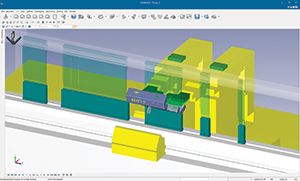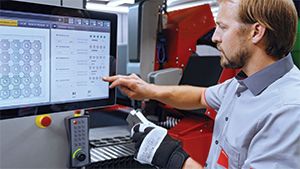by Noelle Stapinsky
Leveraging software capabilities and assist gas innnovation is helping fine tune fiber laser cutting process efficiencies
Over the past two years manufacturers have had to change gears rapidly to keep pace and remain competitive as they navigated through the overall global disruptions caused by the pandemic. The skilled labour shortage became even more accentuated, accelerating the adoption of automation and fully integrated process systems. And now, amidst a global supply chain crisis, job shops and OEMs alike are not only focused on reshoring vital suppliers, but further improving overall efficiencies on the shop floor. And while fiber laser cutting technology is already widely adopted and known for its speed and accuracy, the real game changer is the software running these machines and developments in assist gas, taking the process to the next level.
Technology manufacturers all offer software suites of programming modules that allow shops to fully integrate the entire production flow. The focus is to make these solutions push button simple and allow the software to interpret imported files and communicate parameters from one process to the next. Real time data can also be harvested and analysed to fine tune production capacity and allow companies to make informed decisions on operational costs.
Smart Suitest
TRUMPF machines all have an OPC UA monitoring interface that allows customers to easily extract data, according to Brett Thompson, laser technology and consulting manager, and the TruTops Fab MES system, which is a module designed to manage production flow, also gathers a fair amount of data.
Before there were integrated suites, parts cut with a fiber laser, for example, could be ruined in the forming process if by chance the wrong tooling combination was used to bend the part. “What we’ve done is develop a suite [of modules] where files are imported, and the software interprets them,” says Thompson. “Within the modules there are areas where you program the cutting and bending processes. So rather than treating those things as separate, which they absolutely are not, one depends on the next. If there are modifications made to either the cutting or bending process, the system will indicate if it is correct or if it needs to be reprocessed. The amount of internal intelligence and algorithms has grown a lot.”
TRUMPF has recently added some new software features to its suite. The first, Thompson points out, is the EdgeLine Bevel solution that gives the machine the capability to produce bevels for hardware countersinks or as an edge preparation for welding. “This process is very much dependent on the software, which has a post processor that determines the behaviour of the laser’s power level and positions.”
Typically, fabricators would perform beveling processes before welding using milling or grinding machines, which is very cumbersome and time consuming. The EdgeLine Bevel feature creates the beveled edges while cutting the contours of the parts. During the welding process, metal flows into the bevels to create a high-quality weld seam.
“Another feature called TruControl, I think is quite profound, as it’s somewhat software dependent but also a machine function. It’s a beam management system for our TruDisk laser cutting machine tool. We can measure the power and consistency, and can split it to different outlets,” says Thompson. “It runs through an advanced control interface that gives us the ability to quickly process information, even spatially.”
To reduce post processing, TRUMPF has also introduced a new “nano joints” technology that allows parts to be nested closer together. The nano joints hold the parts in place during the cutting process and are easily broken off when parts are removed from the nest. This means reduced costs, as the parts don’t need to be moved to a tab removal station, and material usage. This technology is available on TRUMPF 1000, 3000 and 5000 series machines and it’s offered as a software update on existing machines.
LVD’s CADMAN suite is a fully integrated software package for designing, production planning and programming for laser cutting, punching and bending sheet metal parts. “CADMAN is comprised of different modules,” says Stefan Colle, laser product sales manager for LVD North America. “It starts, of course, with the laser module to program the laser profile, but it can go much further than that. We have a software called SDI (smart drawing importer) that helps you import parts or drawings from different sources more easily and prepares the part for any further steps in the programming.”
CADMAN suite is a fully integrated software package for designing, production planning and programming for laser cutting, punching and bending sheet metal parts. “CADMAN is comprised of different modules,” says Stefan Colle, laser product sales manager for LVD North America. “It starts, of course, with the laser module to program the laser profile, but it can go much further than that. We have a software called SDI (smart drawing importer) that helps you import parts or drawings from different sources more easily and prepares the part for any further steps in the programming.”
Too often, people that are creating part drawings, using programs like Solidworks or Autodesk Inventor, mistakenly draw lines twice or copy lines that you can’t see from a visual perspective. “Or if you have a right and left side and the designer mirror faces those, sometimes lines can be drawn twice,” says Colle. “The software has to use that information to turn the drawing into a part and that second line needs to be taken out otherwise the laser will cut twice.” SDI will catch those design flaws and prepare the file. It also can recognize and deconstruct an assembly of components in a drawing and prepare them as separate files for cutting.
CADMAN-JOB, another module, is designed to automate the programming portion, making that process less time consuming, and taking it out of the programmers’ hands. It communicates with a company’s enterprise resource planning (ERP) system. “When an order comes in from a customer, that order will communicate with our CADMAN software, telling it the due date, what parts are involved, the quantity, material information and where the drawings or files are located. All that information can be processed by CADMAN-JOB and communicated directly with CADMAN-L where the nesting software is located,” says Colle. “It can then start to organize production jobs in terms of priority. For people buying these high-powered lasers, cutting speeds are quite high and a lot of material gets processed per day. To keep track of all these elements without the help of software becomes challenging and CADMAN-JOB can be a very powerful tool to have.”
In the Mix
Of course, the fiber laser power race is still in full force and most technology manufacturers have already launched 20 kW systems designed to process thicker materials. But with this increased power and speed, manufacturers are exploring how the envelope can be pushed even further with assist gas mixing technology.
While gas mixing—blending oxygen with nitrogen—is not new, many manufacturers have always defaulted to a saturation of oxygen between five and seven per cent, but that saturation level sometimes changes based on material type, thickness and grades. To dial the mix in and recalibrate the system can be a very lengthy process, meaning production downtime.
“Let’s say a job shop is running a 3000-grade aluminum and is using seven per cent oxygen in the mix, but when they’ve finished that job they’re going to cut mild steel, which performs better at five per cent,” says Dan Cortez, application manager of the Americas market region for Bystronic. “Normally they would have to turn their laser down, shut off a bunch of valves and bleed out all that pressure, then go through the process of reinitiating for that correct saturation level. Bystronic is pioneering some new technologies that will allow us to change the saturation on demand with the user’s HMI. So with this on-demand system you can now go from one obscure grade of aluminum to production mild steel in about 45 seconds.”
 To help alleviate the implementation of a new gas type, Bystronic has recently launched a new parameter tuning function that is an upgradable feature for its laser cutting machines. “It’s a user interactive software functionality that prompts the user to cut parts, the operator then ranks the parts one through five, and picks the best part based on that selection to make more parts,” says Cortez. “As you go through this evolution, the machine tool is selecting certain parameters and auto tuning the process, allowing the user to dial in that new gas type in 20 minutes or lesss—a process that could take significantly longer.”
To help alleviate the implementation of a new gas type, Bystronic has recently launched a new parameter tuning function that is an upgradable feature for its laser cutting machines. “It’s a user interactive software functionality that prompts the user to cut parts, the operator then ranks the parts one through five, and picks the best part based on that selection to make more parts,” says Cortez. “As you go through this evolution, the machine tool is selecting certain parameters and auto tuning the process, allowing the user to dial in that new gas type in 20 minutes or lesss—a process that could take significantly longer.”
For fiber laser cutting systems, a dialed in gas mix will improve edge quality and push the technology beyond its typical limits for faster processing times. “With a 20-kW laser you can cut thicker material, up to 1 1/2 -inch (3.81 cm). But by mixing nitrogen with oxygen in the assist gas, you will achieve significantly faster cutting speeds and with a good edge quality,” says Colle. “With pure oxygen you’d normally be cutting at 50 inches (127 cm) per-minute. But with new mixed assist gas, you can now cut thick mild steel at 180 inches (457 cm) per minute.”
Thompson adds that when considering what assist gas should be used for cutting there is always a calculation you need to do. “Is it cheaper to use nitrogen, cut a bit quicker, but deal with burrs? Or use oxygen, cut slower, use less gas, but you’ll need to remove an oxide layer after? You’re still having that formula you need to work out, but it depends on the thickness of the material. Fusion cutting changes that formula. And you have the benefits of speed, quality, process reliability and even capacity.”
The days of metalworking shops looking at just a laser cutting solution are all but gone. Today’s manufacturers want a complete solution for the automation around the machines, the software driving them, and technological advancements to push capacity and improve quality. And those developing such solutions are clearly stepping up, helping the industry move closer and closer to smart factories. SMT
